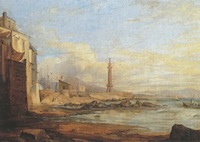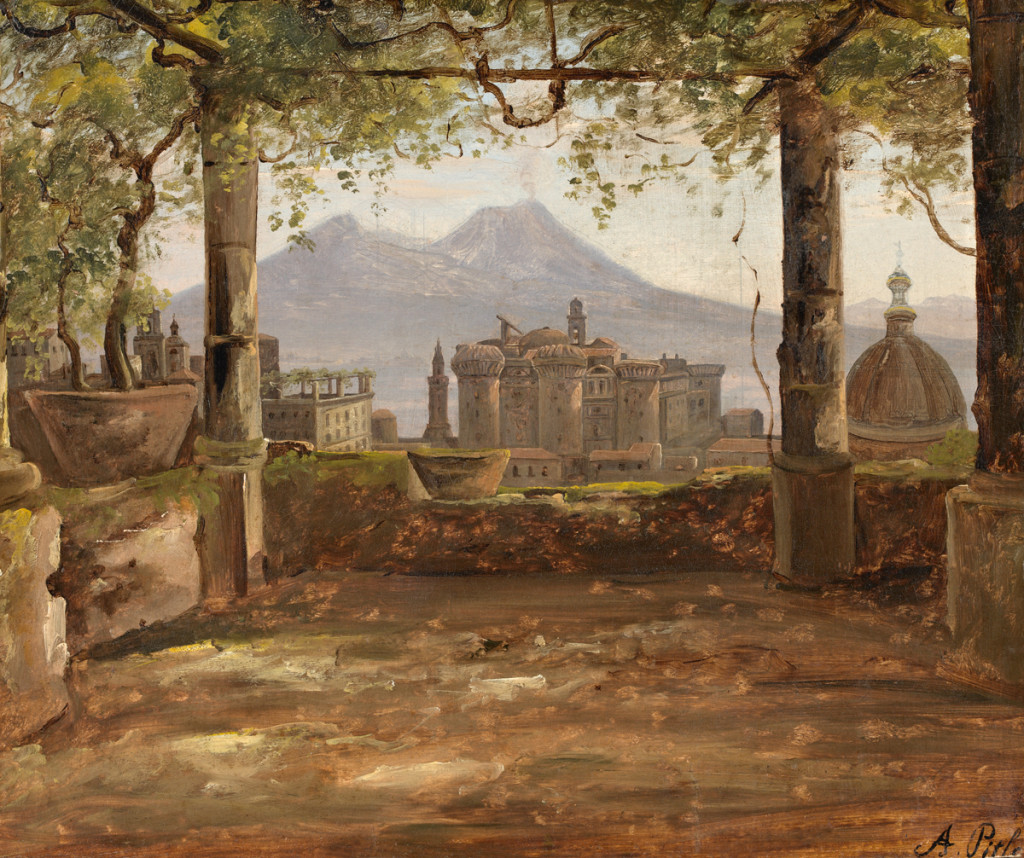Anton Sminck van Pitloo (Arnhem 1790 - 1837 Naples)
View of the Castel Nuovo and Vesuvius from a Pergola, Naples, c.1820
Oil on cardboard, 28.5 x 34.7 cm
Signed lower right A. Pitloo
Provenance:
Private collection, Germany
Anton Sminck van Pitloo[1] began his artistic training in his native Arnhem. He went on to study in Paris and Rome supported by a grant he had received from Louis Bonaparte, Louis (Lodewijk) I of Holland, in 1808. Louis was Napoleon’s younger brother. Napoleon had put him on the throne of the newly created Kingdom of Holland in 1806. In Paris, Pitloo first continued his studies under the celebrated architect Charles Percier but took up landscape painting in 1810. He began to frequent the studios of Jean-Joseph-Xavier Bidauld (1758-1846) and Jean-Victor Bertin (1767-1842). Bertin was to instruct Jean-Baptiste-Camille Corot in landscape painting.
Pitloo is known to have spent three years in Paris. Records show that he was in Rome in 1811, where he figured in Dutch artistic circles and was in contact with painters like Abraham Teerlink, Hendrik Voogd and Martin Verstappen. Pitloo’s work attracted several distinguished patrons – commissions from Louis Bonaparte and the Duke of Berwick are documented. In late 1814 he accompanied the Russian diplomat Count Grigory Vladimirovich Orlov on a visit to Naples. He was to live in the city until his death in 1837 at the age of forty-seven.
In the eighteenth century, Naples became highly popular as one of the obligatory stages on the Grand Tour. It was also a key destination for many artists from England, Germany and France, such as Joseph Wright of Derby, Jakob Philipp Hackert and Joseph Vernet. The city continued to attract leading painters well into the nineteenth century, among them Turpin de Crissé (between 1808 and 1824), Franz Ludwig Catel (a regular visitor from 1812 onwards), Joseph Rebell (between 1813 and 1815), Wilhelm Huber (between 1818 and 1821), JMW Turner (in 1819-20), Achille-Etna Michallon (in 1820) and Johan Christian Clausen Dahl (in 1820-21). Carl Gustav Carus and Corot both visited in 1828.
Pitloo opened a private academy of painting at his house on the Vico del Vasto in Chiaia, the waterfront district of Naples, in 1820. His studio became an important meeting place for talented young artists such as Achille Vianelli, Giacinto Gigante and Gabriele Smargiassi. The group included Teodoro Duclère, who would later marry Pitloo’s daughter. From this nucleus emerged the School of Posillipo.[2] The School was based on a revival of interest in the eighteenth-century veduta tradition and developed a new focus on plein-air painting. The period 1815 to 1830 was decisive in the development of Neapolitan painting, and Pitloo indisputably the key figure in the period.’[3] He was appointed professor of landscape painting at the Accademia di belle arti di Napoli in 1824. He contributed work to exhibitions at the Real Museo Borbonico in 1826 and 1830.

Fig. 1 Anton Sminck van Pitloo, The Lighthouse in Naples Harbour, oil on canvas, 24 x 32 cm, Naples, Museo di San Martino, inv. 21642
In this small-format oil study Pitloo has chosen a high viewpoint, looking out from the shady interior of a vine-clad pergola towards the Castel Nuovo, a noted Neapolitan landmark often referred to as the Maschio Angioino. Facing the viewer are the three distinctive towers of the castle. The towers are flanked at the left by the pinnacle of the harbour lighthouse (Fig. 1). Vesuvius, emitting a light plume of smoke, dominates the background. The study was almost certainly executed en plein air. Pitloo’s handling of the effects of light is highly original in the rendering of the dappled light on the terrace in the foreground and in the treatment of the sun-drenched middle ground and the light-suffused background.
[1] See Marina Causa Picone and Stefano Causa (eds.), Pitloo. Luci e colori del paesaggio napoletano, exhib. cat., Museo Pignatelli, Naples 2004, pp. 89-118.
[2] Pasquale Villari, writing in 1855, described the ‘Scuola di Posillipo’ as follows: The splendid climate and magnificent scenery surrounding Naples, together with the many foreigners who are always asking for a drawing or painting as a memento, had spurred on a number of painters. The artists of the Accademia spoke of them somewhat disparagingly as the ‘School of Posillipo’, after the place where they lived in order to be close to their foreign clients. Raffaello Causa, ‘The School of Posillipo - La Scuola di Posillipo’, in 19th century landscape painting in Naples. Giacinto Gigante e la Scuola di Posillip, exhib. cat., National Museum of Archaeology Valletta, 23 November 2000-20 January 2001, Naples 2000, p. 14-5. [La bellezza del clima, i paesaggi stupendi che circondano Napoli e i molti forestieri che ne chiedono sempre qualche ricordo disegnato o dipinto, avevano fatto sorgere un certo numero di artisti i quali, come per disprezzo, erano dagli accademici chiamati della «Scuola di Posillipo», dal luogo dove abitavano per essere più vicino ai forestieri.]
[3] Picone and Causa, op. cit., 2004, p. 44.

